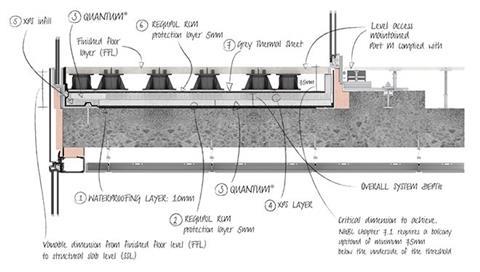This module outlines the key benefits of inverted roof systems and offers guidance on their specification. It is sponsored by Radmat Building Products

How to take this module
UBM’s CPD distance-learning programme is open to anyone seeking to develop their knowledge and skills. Each module also offers members of professional institutions an opportunity to earn between 30 and 90 minutes of credits towards their annual CPD requirement.
This article is accredited by the CPD Certification Service. To earn CPD credits, read the article and then click the link below to complete your details and answer the questions. You will receive your results instantly, and if all the questions are correctly answered, you will be able to download your CPD certificate straight away.
CPD CREDITS: 60 MINUTES
DEADLINE: 8 APRIL 2016


INTRODUCTION
An inverted, or protected, roof is a type of flat roof construction in which the waterproofing layer is placed below the insulation. This in turn is secured by a layer of ballast or paving, or a green roof. This CPD will outline the main features and benefits of inverted roofs, as well as the key regulations and codes of practice.
TYPES OF ROOF CONSTRUCTION
Cold roofs
In a traditional cold roof, the insulation is placed below the structural deck and the waterproof membrane is installed above the deck. This type of roof is often used in applications such as canopies and unheated buildings. The typical weight of a cold roof is 8kg/m2.
This system relies on a vapour barrier beneath the insulation and incorporates a continuous flow of air to disperse water vapour within the structural void. When this doesn’t work effectively, water vapour can condense within the structure, causing damp and rot and decreasing the efficiency of the insulation.
The waterproofing membrane may also require maintenance as it is exposed to UV degradation and thermal shock: surface temperatures can range from –15˚C at night to 80˚C during the day. Foot traffic from required maintenance can also damage the membrane.
Cold roofs do not meet current Building Regulations Part L requirements for inhabited residential or commercial buildings.
Warm roofs
A warm roof includes insulation above the structural deck. The waterproof covering is placed above the insulation and a vapour control layer is placed below the insulation. A warm roof construction typically weighs 10kg/m2.
Warm roof constructions are able to exceed Building Regulations Part L requirements. However, as with cold roofs, this system leaves the waterproof layer exposed to the elements and to impact damage. Because the membrane is laid above a high-performance insulant, it acts as a heat store, thermally stressing the membrane and contributing to the “urban heat island” effect in cities.
Moreover, high surface temperatures from direct sunlight cause the material to expand and then contract when temperatures drop. Over time, this puts a strain on the waterproofing material and can cause irregularities in the surfaces and cracking.
Ultimately these factors will cause the failure of the roofing system, typically after between 10 and 40 years, depending on the waterproofing material.
Inverted roofs
Because of the need for ballast, paving or vegetation, inverted roofs typically weigh about 90kg/m2, which means the structural load is the main limit on their application.
Inverted roofs are able to exceed Building Regulations Part L requirements, and have many advantages. Placing the thermal insulation above the waterproofing membrane:
- maintains waterproofing at an even temperature close to the building’s interior
- protects waterproofing from UV radiation and impact damage
- enables the waterproof layer to act as a vapour barrier, eliminating the risk of condensation within the roof construction.
The ballasted roof also significantly reduces the urban heat island effect.
CONSTRUCTION
Structural decking
Inverted roofing is typically installed on a concrete deck, because a loading of 80kg/m2 is required to retain the insulation on the roof. Glue laminated timber is also sometimes used.
In-situ concrete is the easiest to apply, ideally without a screed to falls (see “Zero falls”, below) as this can complicate the application and delay the installation programme. In-situ concrete typically requires a minimum of 28 days to cure prior to roofing works commencing. The relevant British standard is BS EN 13670:2009.
Precast concrete can also be used, with or without a screed, but the installation method will alter slightly as the panel gaps must be considered if not using a screed. If screeded, the screed will require a drying time. The relevant standard is BS EN 13693:2004+A1:2009.
Waterproofing membranes
The main types of waterproofing used in inverted roofs are reinforced bitumen membranes (RBMs), single-ply membranes, liquid applied membranes and hot melt monolithic waterproofing.
- Reinforced bitumen membranes RBMs were traditionally a common option for inverted roofs but are used more rarely today. This is partly due to the fact that they require a two-layer application, which takes time and skill, and makes detailing difficult. They can be fully bonded or loose-laid, and range in thickness from 6-8mm, which increases resistance to following trades. They typically last for 20-35 years.
- Single-ply membranes These are mostly used in warm roof applications, but suppliers will also specify them in inverted roofs. Their thickness ranges from 1.2-2mm, which makes them prone to puncture or damage by following trades. They are usually loose-laid, and joints are hot-air-welded, which requires skill and experience. No single-ply is currently certified for zero-falls application, so will require a screed to falls to comply with Building Regulations. This adds costs and prolongs the programme. Single-ply membranes typically last for 20-30 years.
- Liquid-applied membranes These are most commonly used in refurbishments, but many are also suitable for inverted roofs. Thickness ranges from 1.2-2mm, so there is a risk of damage or puncture. They are fully bonded and usually need a two-coat application, but this requires less skill than single-ply. Detailing is relatively straightforward as they accommodate penetrations easily. Their design life is 20-35 years.
- Hot melt monolithic membranes These are the most common waterproofing for inverted roofs. Thicknesses range from 8-10mm, which means there’s a minimal risk of damage by following trades. They are fully bonded to primed substrate, preventing water tracking if punctured. The two-coat application is easy to apply, and they accommodate high volumes of penetrations easily. They are certified by the British Board of Agrément (BBA) for “the design life of the roof or structure in which they are incorporated”.
Insulation
There are two main generic types of insulation for inverted roofs: extruded polystyrene (XPS) and expanded polystyrene (EPS). Specifiers should check that products are certified by the BBA for inverted roof applications, green roofs and roof gardens. They should also check that the declared thermal conductivity (or lambda value) is calculated to BBA specifications, and that the moisture conversion factor and rainwater cooling factor required by European standard ETAG 031 have been applied.
- XPS The traditional choice for inverted roof systems, and available from a number of manufacturers. It should be manufactured to BS EN 13164. Some manufacturers have improved the lambda value of boards to 0.034W/m2K, enabling a 200mm-thick board to achieve a U-value of 0.15. ETAG 031-1 states that XPS is suitable for untrafficked or pedestrian areas, green roofs, roof gardens and parking decks.
- EPS should be manufactured to BS EN 13163. The thermal performance is slightly lower than for XPS – a 220mm-thick board has a lambda value of 0.038W/m2K. ETAG 031-1 states that EPS is also suitable for untrafficked or pedestrian areas, but not for green roofs, roof gardens and parking decks.
- Vacuum insulated panels VIP is a new technology that provides a high-performance alternative to traditional insulation – 40mm-thick panels can achieve lambda values as low as 0.007W/m2K. The downside is the higher cost per m2, although on buildings over 20 storeys, the material’s thinness offers the possibility of including an extra floor. There is currently no European standard, and BBA certification is in progress.
DESIGN CONSIDERATIONS
Zero falls
BS 6229:2003 is the document that the Building Regulations refer to in the case of falls on flat roofs. It specifies minimum finished falls of 1:80, which is achieved by designing to 1:40 in order to allow for a 25mm deflection every 1m. However, in 2016, BS 6229 will be updated to include zero falls applications as defined by the BBA in Building Bulletin 4. This defines zero falls as between 0˚ and 0.7˚. The NHBC has also recognised zero falls construction in its Chapter 7.1 standards publication, which was updated in November 2015.
When checking the suitability of a roof for zero falls application, it is important to ensure the manufacturer assesses the deflection plan for the deck to identify any low points that are not near rainwater outlets. If the outlets cannot be moved to areas of high deflection, the options of increasing ballast, paving or green roof loading locally to disperse the water should be considered.
Sustainability
The thermal insulant and the deck type have the biggest impact on an inverted roof’s Green Guide to Specification rating. Most of the inverted roof insulation boards have an A or A+ rating, but as an inverted roof is usually on a concrete deck, the overall rating will be C or D.
The Green Guide informs BREEAM ratings, and here the biggest additional contribution will be the ISO 14001 certification for the manufacture of the waterproofing and the insulation. Biodiverse and intensive green roofs can also add points. In recent years, the BRE has linked its BES 6001 Responsible Sourcing of Construction Products assessment to BREEAM. Currently no roofing system manufacturer has achieved a BES 6001 rating.
Hot melt monolithic membranes have been approved under the Google Healthy Materials Programme.

How to take this module
UBM’s CPD distance-learning programme is open to anyone seeking to develop their knowledge and skills. Each module also offers members of professional institutions an opportunity to earn between 30 and 90 minutes of credits towards their annual CPD requirement.
This article is accredited by the CPD Certification Service. To earn CPD credits, read the article and then click the link below to complete your details and answer the questions. You will receive your results instantly, and if all the questions are correctly answered, you will be able to download your CPD certificate straight away.
CPD CREDITS: 60 MINUTES
DEADLINE: 8 APRIL 2016
Privacy policy
Information you supply to UBM Information Ltd may be used for publication and also to provide you with information about our products or services in the form of direct marketing by email, telephone, fax or post. Information may also be made available to third parties. UBM Information Ltd may send updates about Building CPD and other relevant UBM products and services. By providing your email address you consent to being contacted by email by UBM Information Ltd or other third parties. If at any time you no longer wish to receive anything from UBM Information Ltd or to have your data made available to third parties, contact the Data Protection Coordinator, UBM Information Ltd, FREEPOST LON 15637, Tonbridge, TN9 1BR, Freephone 0800 279 0357 or email ubmidpa@ubm.com. View our full privacy policy at www.building.co.uk/cpd





























No comments yet